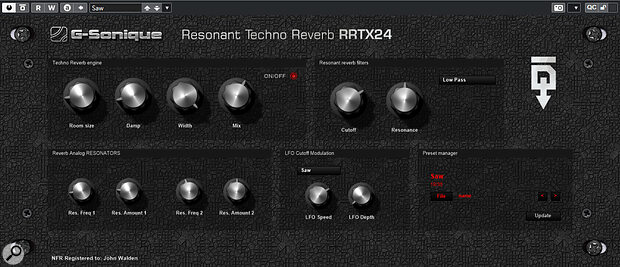 RRTX24’s UI is somewhat industrial in vibe but perfectly functional in use.
RRTX24’s UI is somewhat industrial in vibe but perfectly functional in use.
Seeking creative inspiration? This reverb might be up your street if you are a Windows user...
Almost every mainstream DAW now includes a plug‑in bundle containing one or more reverb plug‑ins, so pretty much every computer‑based music producer already has access to a selection of spring, plate, hall or other standard reverb ‘spaces’. But if your music making features an experimental streak, you’ll probably enjoy reverb effects that offer a little more ‘creative inspiration’ — and, if you use a Windows‑based machine you might find that G‑Sonique’s RRTX24 Resonant Techno Reverb, described by the developers as an “algorithmic FX extraterrestrial reverb”, might appeal.
G‑Sonique are a small development team based in the Slovak Republic, and while the RRTX24 has been my first encounter with their plug‑ins it seems they were founded back in 2007, and they already offer lots of modestly priced virtual instruments, effects plug‑ins and sample packs. Their effects line‑up includes a number of EQ, compression and tape emulation/saturation plug‑ins (mostly for Windows, but some can run on Mac OS) whose hardware inspiration is hinted at by their visuals. But there is also a line of more creative and/or experimental effects, and the RRTX24 most certainly fits into this category.
In Use
As you can see in the screenshot, the GUI is more functional than fancy, with a dark, almost industrial vibe. The main controls are split into four panels. There’s a Preset Manager panel too, but you may find you don’t need it, since in my tests Cubase Pro 12’s plug‑in preset system seemed to have direct access to the presets.
G‑Sonique’s website describes RRTX24 as an “algorithmic reverb” but, in the absence of any formal documentation or any instructional video, you’re pretty much left to your own devices to work out how the various controls interact. With appropriate settings, you can essentially bypass the filters, resonators and LFO modulation (it would be a cool addition if there were individual bypass buttons for these three elements!) and dial in some very usable conventional reverb flavours, using just the controls within the Techno Reverb Engine panel.
It’s sci‑fi, alien, industrial and artificial... and that, of course, is the whole point! The results can be weird, unconventional but also wonderful.
However, once you move beyond the Engine panel, in sonic terms things can quickly get experimental. For example, the different filter types (various low, high, band and peaking filters are available) can radically alter the nature of the reverb, while the LFO modulation can go from gentle movement to adding an extreme sound‑design rhythmic element. That’s great for old‑school modulation, though there’s no option to sync the LFO to the host’s tempo, which I might sometimes have appreciated. The Resonators panel lets you take your experimentation even further and, by this stage, you are able to go well beyond any conventional ‘space’. It’s sci‑fi, alien, industrial and artificial... and that, of course, is the whole point! The results can be weird, unconventional but also wonderful.
Naturally, this means this won’t be a plug‑in for everyone. But it most certainly could appeal to sound designers, whether for musical contexts or music‑to‑picture sound effects, and in a purely musical context, electronic music producers could definitely enjoy adding some of these unusual sonic textures to their productions, be that on drums, guitars, synths, bass or vocals. RRTX24 can certainly do ear‑catching, and that often means that it suits less busy/more minimal musical arrangements; the quirkiness of the reverb often works best if the mix leaves some space in which it can shine.
Verdict
I don’t know if RRTX24 is typical of G‑Sonique’s broader range. But given the combination of unusual features and wallet‑friendly price, it could find favour with lots of independent electronic music‑makers with a minimalist music production setup. If that’s you, and you’re working on a Windows system, there’s a trial version available to download on G‑Sonique’s website, and I’d very much encourage you to try it out.
Summary
If you’re a Windows user on the lookout for some experimental reverb options, G‑Sonique’s RRTX24 plug‑in is well worth exploring — and it won’t break the bank!
Information
€32.99. (Discounted to €19.90 when going to press.)
€32.99. (About $35. Discounted to €19.90/$22 when going to press.)
